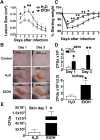Chronic ethanol feeding increases the severity of Staphylococcus aureus skin infections by altering local host defenses
- PMID: 25605871
- PMCID: PMC4370047
- DOI: 10.1189/jlb.4A0214-092R
Chronic ethanol feeding increases the severity of Staphylococcus aureus skin infections by altering local host defenses
Abstract
Alcoholics are at increased risk of Staphylococcus aureus skin infection and serious sequelae, such as bacteremia and death. Despite the association between alcoholism and severe S. aureus skin infection, the impact of EtOH on anti-S. aureus cutaneous immunity has not been investigated in a model of chronic EtOH exposure. To test the hypothesis that EtOH enhances the severity of S. aureus skin infection, mice were fed EtOH for ≥12 weeks via the Meadows-Cook model of alcoholism and inoculated with S. aureus following epidermal abrasion. Evidence of exacerbated staphylococcal disease in EtOH-fed mice included: skin lesions that were larger and contained more organisms, greater weight loss, and increased bacterial dissemination. Infected EtOH-fed mice demonstrated poor maintenance and induction of PMN responses in skin and draining LNs, respectively. Additionally, altered PMN dynamics in the skin of these mice corresponded with reduced production of IL-23 and IL-1β by CD11b(+) myeloid cells and IL-17 production by γδ T cells, with the latter defect occurring in the draining LNs as well. In addition, IL-17 restoration attenuated S. aureus-induced dermatopathology and improved bacterial clearance defects in EtOH-fed mice. Taken together, the findings show, in a novel model system, that the EtOH-induced increase in S. aureus-related injury/illness corresponds with defects in the IL-23/IL-17 inflammatory axis and poor PMN accumulation at the site of infection and draining LNs. These findings offer new information about the impact of EtOH on cutaneous host-defense pathways and provide a potential mechanism explaining why alcoholics are predisposed to S. aureus skin infection.
Keywords: IL-17; PMNs; T cells.
© Society for Leukocyte Biology.
Figures






Similar articles
-
Chronic ethanol feeding induces subset loss and hyporesponsiveness in skin T cells.Alcohol Clin Exp Res. 2014 May;38(5):1356-64. doi: 10.1111/acer.12358. Epub 2014 Feb 11. Alcohol Clin Exp Res. 2014. PMID: 24512045 Free PMC article.
-
IL-17 is essential for host defense against cutaneous Staphylococcus aureus infection in mice.J Clin Invest. 2010 May;120(5):1762-73. doi: 10.1172/JCI40891. Epub 2010 Apr 1. J Clin Invest. 2010. PMID: 20364087 Free PMC article.
-
Neutrophil-derived IL-1β is sufficient for abscess formation in immunity against Staphylococcus aureus in mice.PLoS Pathog. 2012;8(11):e1003047. doi: 10.1371/journal.ppat.1003047. Epub 2012 Nov 29. PLoS Pathog. 2012. PMID: 23209417 Free PMC article.
-
Innate and adaptive immune responses against Staphylococcus aureus skin infections.Semin Immunopathol. 2012 Mar;34(2):261-80. doi: 10.1007/s00281-011-0292-6. Epub 2011 Nov 6. Semin Immunopathol. 2012. PMID: 22057887 Free PMC article. Review.
-
Host-pathogen interactions between the skin and Staphylococcus aureus.Curr Opin Microbiol. 2012 Feb;15(1):28-35. doi: 10.1016/j.mib.2011.11.003. Epub 2011 Dec 1. Curr Opin Microbiol. 2012. PMID: 22137885 Free PMC article. Review.
Cited by
-
Effect of ethanol exposure on innate immune response in sepsis.J Leukoc Biol. 2024 May 29;115(6):1029-1041. doi: 10.1093/jleuko/qiad156. J Leukoc Biol. 2024. PMID: 38066660 Free PMC article. Review.
-
Alcohol use disorder increases the risk of necrotizing fasciitis: A nationwide retrospective cohort study.Medicine (Baltimore). 2017 Aug;96(32):e7509. doi: 10.1097/MD.0000000000007509. Medicine (Baltimore). 2017. PMID: 28796035 Free PMC article.
-
The Role of Oxidative Stress in Skin Disorders Associated with Alcohol Dependency and Antioxidant Therapies.Molecules. 2025 Jul 25;30(15):3111. doi: 10.3390/molecules30153111. Molecules. 2025. PMID: 40807286 Free PMC article. Review.
-
Ethanol consumption synergistically increases ultraviolet radiation induced skin damage and immune dysfunction.J Dermatol Sci. 2021 Jan;101(1):40-48. doi: 10.1016/j.jdermsci.2020.11.001. Epub 2020 Nov 5. J Dermatol Sci. 2021. PMID: 33213984 Free PMC article.
-
Periorbital necrotizing fasciitis: the Manchester experience.BMC Ophthalmol. 2025 Apr 17;25(1):221. doi: 10.1186/s12886-025-04062-3. BMC Ophthalmol. 2025. PMID: 40247190 Free PMC article.
References
-
- Miller L. G., Diep B. A. (2008) Clinical practice: colonization, fomites, and virulence: rethinking the pathogenesis of community-associated methicillin-resistant Staphylococcus aureus infection. Clin. Infect. Dis. 46, 752–760. - PubMed
-
- Capdevila O., Grau I., Vadillo M., Cisnal M., Pallares R. (2003) Bacteremic pneumococcal cellulitis compared with bacteremic cellulitis caused by Staphylococcus aureus and Streptococcus pyogenes. Eur. J. Clin. Microbiol. Infect. Dis. 22, 337–341. - PubMed
-
- Forsblom E., Ruotsalainen E., Mölkänen T., Ollgren J., Lyytikäinen O., Järvinen A. (2011) Predisposing factors, disease progression and outcome in 430 prospectively followed patients of healthcare- and community-associated Staphylococcus aureus bacteraemia. J. Hosp. Infect. 78, 102–107. - PubMed
Publication types
MeSH terms
Substances
Grants and funding
LinkOut - more resources
Full Text Sources
Medical
Research Materials

